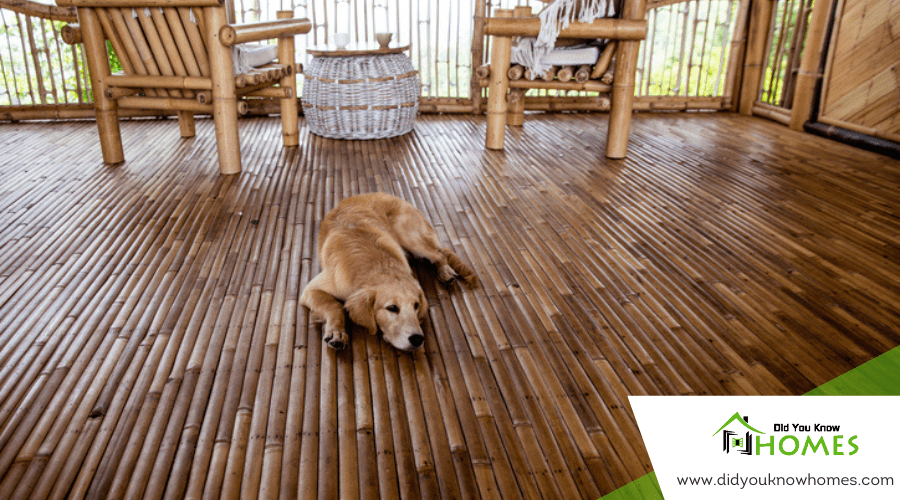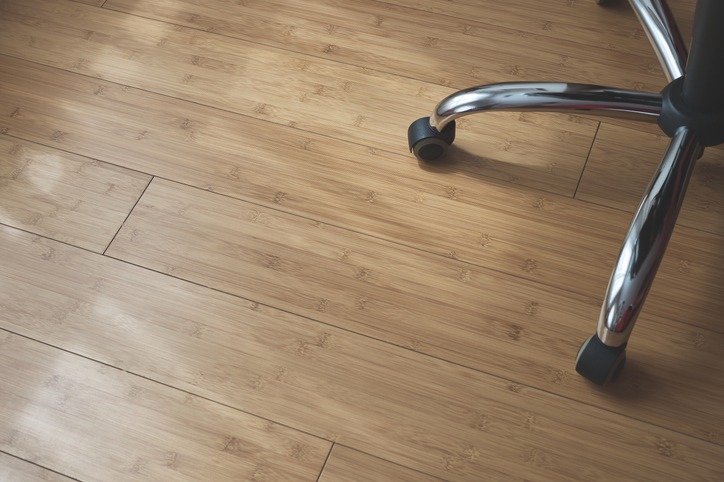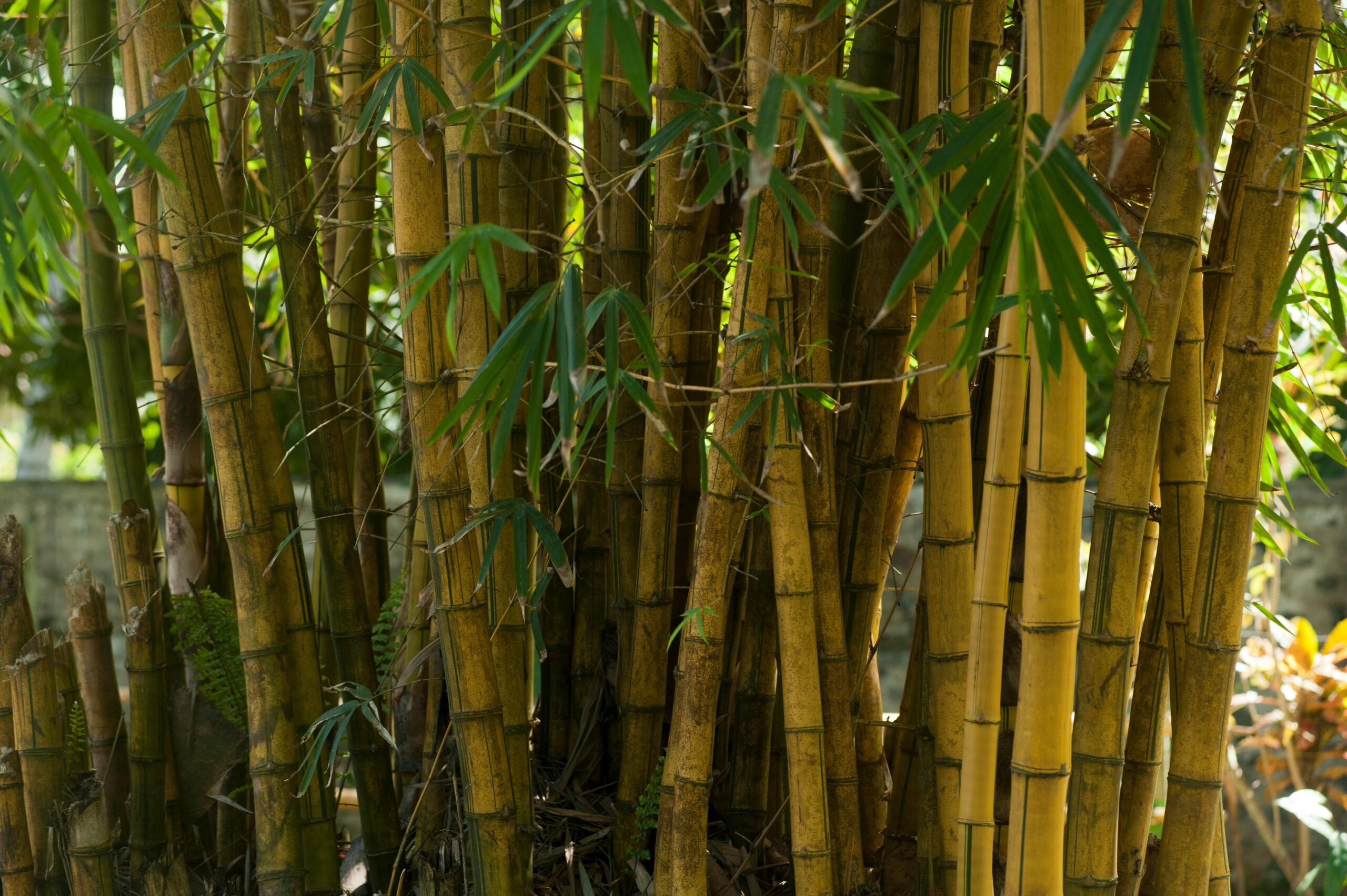You’re choosing wisely with bamboo flooring. It’s not just tough; it’s kind to the planet. Imagine a floor that matures in just 5 years, thrives without extra water or fertilizers, and can shoot up 4 feet daily. Bamboo doesn’t just grow fast; it’s a renewal champ, cutting down on carbon emissions and demanding less from the earth. Plus, it’s versatile in installation, easy to keep looking sharp, and comes with a promise of low environmental impact through FSC certification. And here’s the kicker: it lasts. With the right care, your bamboo floor can endure beautifully. Curious? There’s plenty more to uncover.
Key Takeaways
- Bamboo flooring is a renewable resource, maturing in about 5 years and self-regenerating without depleting resources.
- It has a lower environmental impact, with bamboo forests producing 30% more oxygen and reducing carbon emissions.
- Bamboo is durable and can be sanded and refinished multiple times, extending its lifespan.
- The manufacturing process of bamboo flooring aims to minimize transportation emissions, enhancing its eco-friendly profile.
- Installation methods include floating, glue-down, and nail-down, with maintenance involving regular sweeping and gentle cleaning to preserve its quality.
Understanding Bamboo
Bamboo, a fast-growing grass, matures within 5 years, offering you a renewable and sturdy flooring choice. Unlike traditional hardwoods that take decades to grow, bamboo’s quick maturity and intact root system mean it can replenish itself rapidly, ensuring a continuous supply without depleting resources. This feature not only positions bamboo as a sustainable building material but also highlights its role in responsible management practices. By choosing bamboo, you’re opting for an environmentally friendly solution that requires minimal water and fertilizer to thrive.
Moreover, bamboo’s durability surpasses that of most hardwoods, making it a long-lasting option for your home. Its natural strength means your floors can withstand the rigors of daily life, ensuring you won’t need to replace them as often as other materials. Bamboo’s biodegradable nature further underscores its environmental benefits, aligning with a lifestyle focused on reducing ecological impact. By selecting bamboo flooring, you’re not just making a smart choice for your space; you’re contributing to a more sustainable and durable future.
Sustainability Factors
When you choose bamboo flooring, you’re not just picking a durable option, but you’re also making a positive impact on the environment. Its quick growth rate and ability to regenerate without replanting make bamboo a standout renewable resource. Plus, its production greatly lowers carbon emissions, showcasing its role in promoting a greener planet.
Bamboo Growth Rate
How swiftly does bamboo grow, you might ponder, especially when considering its sustainability as a flooring option? Well, bamboo’s growth rate is nothing short of impressive. It stands as one of the fastest-growing plants on Earth, shooting up to 4 feet in a single day. Unlike traditional hardwood trees, which take decades to mature, bamboo reaches maturity in just about 5 years. This quick turnaround and its ability to self-regenerate without the need for replanting make bamboo an incredibly sustainable and eco-friendly choice. Here’s a quick look at why bamboo flooring is a green choice:
| Feature | Benefit | Sustainability Impact |
|---|---|---|
| Fast Growth Rate | Up to 4 feet/day | Rapid Replenishment |
| Maturity | 5 years to mature | Reduced Harvesting Time |
| Self-Regenerating | No need for replanting | Eco-Friendly |
| Continuous Growth | Harvested in sections | Ensures Sustainability |
Bamboo’s ability to grow quickly and sustainably makes it a top choice for eco-conscious consumers.
Carbon Footprint Reduction
You’ll notice a significant reduction in your carbon footprint by choosing bamboo flooring due to its rapid growth and sustainable harvesting practices. Bamboo’s self-generating root system means it doesn’t need replanting, making it an eco-friendly marvel. This, combined with the fact that bamboo forests produce 30% more oxygen than traditional hardwood forests, highlights its role in sustainable practices. The manufacturing process, primarily located in China, is designed to lower transportation emissions, further cutting down the carbon footprint. By opting for bamboo flooring, you’re not just selecting a durable, stylish option; you’re also contributing to carbon footprint reduction through eco-friendly choices that leverage bamboo’s unique benefits. Embrace bamboo flooring for its sustainable practices and enjoy a greener living space.
Renewable Resource Benefits
Bamboo flooring stands out as an eco-conscious choice, thanks to its status as a rapidly renewable resource that matures in just about five years. Unlike traditional hardwoods that take decades to grow, bamboo’s rapid growth rate and self-regenerating properties make it a superstar in sustainable practices. After harvesting, there’s no need to replant because its root system naturally replenishes itself, guaranteeing continuous growth without additional resources. This makes bamboo not only environmentally friendly but also reduces its environmental impact further because it thrives without irrigation or fertilizers. By choosing bamboo flooring, you’re supporting eco-friendly manufacturing processes. These sustainable practices ensure the preservation of our natural resources, making bamboo an admirable option for those committed to environmental stewardship.
Durability and Strength
When considering flooring options, it’s crucial to acknowledge that bamboo floors are not only environmentally friendly but also surpass most hardwoods in durability and strength. You’re acquiring a surface that can manage the hustle and bustle of daily life, making it ideal for homes bustling with activity. Bamboo’s resilience means it holds up well to heavy foot traffic and impacts that would dent or scratch softer woods.
Strand woven bamboo, in particular, showcases exceptional strength and durability. This type is custom-made for high-traffic areas, resisting the wear and tear that floors often encounter. Whether it’s the continuous patter of feet or the unintentional drop of household items, bamboo flooring holds its ground, maintaining its integrity and appearance.
Furthermore, the innate strength of bamboo guarantees it’s scratch-resistant and capable of enduring damage from fallen objects. However, durability doesn’t just imply surviving the daily routine. Bamboo flooring can be sanded and refinished, rejuvenating the surface and safeguarding it against future wear and tear. Its sustainable and environmentally friendly nature, coupled with unparalleled durability, positions bamboo flooring as a dependable choice for environmentally conscious homeowners seeking a long-lasting, resilient floor.
Aesthetic Versatility
Beyond its impressive durability, bamboo flooring also stands out for its aesthetic versatility, offering a range of styles to enhance any room. You’ll find bamboo’s wide array of grain patterns, colors, and finishes can seamlessly match a variety of interior styles. Whether you’re aiming for the sleek lines of contemporary designs or the cozy, minimalist vibe of Scandinavian themes, bamboo flooring adds that perfect touch of elegance and warmth.
The unique visual appeal of vertical and horizontal grain patterns creates a distinctive, modern feel, setting your space apart. This versatility isn’t just about looks; it’s about making your design preferences come to life. Bamboo flooring allows you to integrate it smoothly with different decor themes, whether you’re decking out a home or sprucing up a commercial space.
Opting for bamboo means you’re not just choosing a floor; you’re selecting a versatile design element that complements a wide array of design preferences. Its aesthetic versatility makes bamboo flooring a favored choice for those seeking sustainable yet visually appealing solutions. You’re guaranteed to find a style that not only meets your eco-conscious values but also elevates the look of your living or work space.
Cost-Effectiveness
Considering the cost of flooring can quickly add up, you’ll find bamboo to be a particularly affordable option that doesn’t skimp on quality. With prices ranging from $2 to $8 per square foot, bamboo flooring emerges as a cost-effective choice that suits a variety of budgets. The average national cost stands at $3.84 per square foot, positioning bamboo as an affordable choice that doesn’t compromise on the aesthetic or durability front.
When it comes to installation costs, bamboo flooring keeps pace with hardwood flooring, ensuring your overall expenses remain manageable. This similarity in installation costs means you won’t be caught off guard with unexpected expenses, making bamboo an even more appealing option for your renovation or new build.
However, it’s important to mention that bamboo flooring comes with quality variations. To make sure you’re getting the best value for your money, sourcing from a reputable dealer becomes key. A reliable supplier guarantees you a product that’s not only durable but also an eco-friendly option for sustainable living. So, when you choose bamboo, you’re not just making a cost-effective decision; you’re also contributing to a greener planet.
Environmental Impact
Turning to the environmental impact of bamboo flooring, you’ll find it’s a clear win for the planet. Its sustainable growth rate and ability to reduce carbon footprints make it a smart choice for eco-conscious consumers. You’re not just choosing a durable floor; you’re supporting a healthier environment.
Sustainable Growth Rate
Bamboo’s rapid growth rate of up to 4 feet a day positions it as an eco-friendly powerhouse in sustainable flooring options. Unlike traditional hardwood trees that need 30-60 years to mature, bamboo’s ready in about 5 years. This dramatically cuts down deforestation rates, making bamboo a champion of environmental preservation. Its intact root system quickly replenishes after harvesting, ensuring a sustainable growth rate with minimal environmental impact. You don’t even need to replant it, thanks to its self-regenerating properties. Bamboo stands out as a rapidly renewable resource and a renewable material. Plus, by harvesting it in sections, we’re practicing responsible management of this fast-growing plant. You’re not just choosing a floor; you’re investing in the planet.
Carbon Footprint Reduction
You’ll greatly reduce your carbon footprint by choosing bamboo flooring, thanks to its sustainable growth and production practices. Bamboo’s rapid growth and self-regeneration mean it has a low environmental impact, unlike traditional hardwoods. Since harvesting doesn’t require replanting, the process further minimizes carbon emissions. What’s more, bamboo forests are powerhouses of oxygen production, generating 30% more oxygen than hardwood forests. This boost in oxygen not only benefits the atmosphere but also combats carbon dioxide levels more effectively. By selecting bamboo flooring, manufactured primarily in China, you’re supporting an industry that markedly lowers carbon emissions compared to other flooring materials. It’s a straightforward choice for anyone looking to make an environmentally conscious decision.
Installation Techniques
When installing bamboo flooring, you have several techniques to choose from, each with its unique benefits. If you’re eyeing a method that skips the mess of glue and the importance of nails, floating bamboo floors are your go-to. This technique employs a click-lock system, allowing the planks to interlock seamlessly without adhesive or nails. It’s not only swift but also allows for easy future replacements or adjustments.
On the flip side, if you’re after something more fixed, the glue-down installation secures your bamboo flooring directly to the subfloor with a strong adhesive. This method promises a sturdy, squeak-less floor, ideal for high-traffic areas. Alternatively, the nail-down installation anchors each bamboo plank to a wooden subfloor using nails, offering an equally solid foundation but with a bit more labor involved.
Before diving into any of these installation techniques, remember to properly acclimatize your bamboo flooring. This important step ensures your planks won’t warp or buckle after installation, maintaining the beauty and durability of your floor for years to come. By choosing the right method and preparing your materials properly, you guarantee a smooth, successful installation.
Maintenance Tips
To maintain your bamboo flooring in top shape, regular sweeping and vacuuming are crucial. This simple routine eliminates dirt and debris, preventing scratches and damage that could affect its appearance. Bamboo’s resilience makes it a fantastic choice for any home, but like any investment, it necessitates care to uphold its beauty and function.
When it’s time for a deeper clean, a bamboo floor cleaner is your best option. It’s formulated to be gentle yet effective, ensuring your floors look their best without harsh chemicals. For those tougher spots, a mild soap and water solution does the job. Keep in mind, the key is to avoid over-saturating your floors with water, which can lead to warping or damage.
Maintenance isn’t just about cleaning; it’s also about protecting your health. Opting for formaldehyde-free bamboo flooring products guarantees you’re not exposing yourself or your family to unnecessary toxins during cleaning. This attention to detail during maintenance not only preserves the quality and longevity of your bamboo flooring but also promotes a healthier living environment.
With the right care, your bamboo flooring will remain a durable, eco-friendly feature in your home for years to come.
Comparing Bamboo and Hardwood
In comparing bamboo and hardwood flooring, it’s evident that bamboo offers a more sustainable and equally durable option. When you’re making a choice for your home, considering the environmental impact and longevity of your flooring is essential. Bamboo stands out for several compelling reasons:
- Sustainable Growth: Bamboo matures in about 5 years compared to 30-60 years for traditional hardwood. This rapid growth cycle guarantees a more sustainable resource.
- Rapid Replenishment: Unlike hardwood forests, bamboo’s intact root system allows for rapid replenishment after harvesting, eliminating the need for replanting and reducing deforestation.
- Durability and Longevity: Bamboo can be sanded and refinished multiple times, much like hardwood, ensuring it lasts for decades. Its durability is on par with many hardwoods, making it a wise investment.
- Lower Carbon Footprint: The growth and manufacturing of bamboo, primarily in China, can notably reduce the carbon footprint, especially when compared to European hardwood flooring. Additionally, FSC certification guarantees that the bamboo is sourced from responsibly managed forests, further reducing its environmental impact.
Choosing bamboo over hardwood doesn’t just benefit your home; it supports a more sustainable and eco-friendly world.
Frequently Asked Questions
Is Bamboo Flooring Eco-Friendly?
Yes, bamboo flooring is eco-friendly. Its fast growth rate and renewable nature, combined with low carbon footprint and minimal plantation impact, make it a top choice. Plus, bamboo harvesting reduces soil erosion, boosting sustainability.
What Are the Downsides of Bamboo Flooring?
You’ll find bamboo flooring’s downsides include moisture sensitivity, scratch susceptibility, and limited styles. Also, beware of color fading and cost considerations. Installation can be tricky, too, so weigh these cons before making your choice.
What Is the Most Durable Bamboo Flooring?
The most durable bamboo flooring is strand woven, thanks to its high ranking on the hardness scale. You’ll find it in various colors, with diverse installation methods and maintenance tips. Check the warranty options too.
What Is the Most Environmentally Friendly Flooring?
Consider cork for its sustainability, linoleum for biodegradability, recycled tile, wool carpets, certified hardwood, and polished concrete. Each offers unique green benefits, fitting different eco-conscious preferences.
Conclusion
In sum, you’ve got a winner with bamboo flooring. It’s not just eco-friendly, but it’s tough as nails, and its style versatility can’t be beaten. You’re looking at a cost-effective choice that lessens your environmental footprint. Plus, installing and maintaining it’s a breeze. When you compare it to traditional hardwood, bamboo’s benefits shine through. So, if you’re considering a flooring upgrade, bamboo’s the way to go. Immerse yourself and make a smart, sustainable choice.




